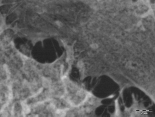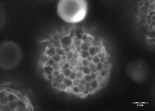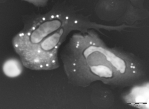
 Home > 제품소개 > WET SEM
Home > 제품소개 > WET SEM
- WETSEM (1)
- QX-102 for imaging of fully- hydrated samples with SEM
-
WETSEMTM TechnologyConcept
- - High resolution imaging of fully hydrated samples.
- Greatly reduces prep time as well as artifacts.
- Capsule and base fits standard SEMs.
- Achieve reliable, reproducible, quantifiable results.
Electron microscopy (EM) is today's primary tool for high-resolution imaging – the cornerstone for research into living organisms and our material environment.
But because EM requires that samples be placed in a vacuum, it has not been suitable for examining wet samples. This single drawback has been a major impediment to the use of EM for biomedical research, as well as for many other clinical and industrial applications. Until now, the only means of imaging a wet sample with EM was to freeze or dry it, effectively changing it's nature in the process. Such sample preparation is also time-consuming, costly, and often introduces artifacts.
El-Mul (QuantomiX) WETSEM® – developed with the cooperation of some of the world's leading life sciences and materials science researchers and labs – dramatically reduces the preparation needs for high-resolution imaging of wet samples, making imaging easier and faster. It also eliminates many of the artifacts that result when preparing wet samples for EM, opening up opportunities for new research methods as well as new processing methodologies in a variety of fields.
WETSEM® also uniquely enables imaging of samples that contain oily and volatile materials. Also for the first time, WETSEM® enables microanalysis using energy dispersive spectrometry (EDS) of wet samples in their native state, a long-awaited capability for many industrial and research labs.
WETSEM® Technology is based on a proprietary capsule that is placed on the specimen stage of a standard SEM. At the heart of the capsule is a patented, nanotech-engineered transparent membrane that completely isolates a wet sample from the powerful vaccuum used in SEM chambers.
The capsule serves the combined function of specimen holder or cell culture dish, depending on the application. This unique receptacle permits electrons to enter and exit the capsule, while maintaining the sample in its natural state at atmospheric pressure.
Imaging is achieved either with backscattered (BSE) electron detection or X-ray detection, revealing high-resolution structure as well as material composition.
WETSEM® is ideally suited for fully-hydrated or liquid-containing samples – including foods, oils, cosmetics, ink, biological cells, tissues, and fluid suspensions. In certain settings, WETSEM® also enables imaging of dynamic reactions and their products.
AdvantagesApplications- Direct imaging of wet samples (food, cosmetics, inks, cells,
tissues).
- Compositional analysis of wet samples by X-ray microanalysis.
- Wide spectrum of staining and labeling capabilities for cells
and tissues.
- Ability to image unstained or unfixed cells and tissues.
- Imaging of both adherent and non-adherent cells.
- High resolution histopathology.
- Intracellular imaging in a scanning EM.
- Imaging the entire cell surface.
- Excellent preservation and imaging of lipid structures.
- Easy-to-automate sample processing and imaging.- Industrial research: food, oils, dyes, emulsions,
pharmaceuticals, suspensions, personal care goods, cosmetics,
inks.
- Quality control and quality assurance.
- Life sciences and medicine: cultured and primary cells,
histology,nerve cells and myelin imaging, microbiology, plants.
- Tissue implants and prostheses.
- Environmental and toxicological applications.
- Clinical diagnosis: histopathology, cytology, oncology.
QX-102 Capsules For cell biology and liquid samples
For cell biology and liquid samples
The QX-102 Capsules are used for imaging various wet materials and biological samples such as food, cosmetics, oils, paints, particles in solutions, adherent and non-adherent cells, and microorganisms. Materials of various consistencies such as foams, gels, creams and emulsions can be easily viewed using the QX-102 Capsule. The samples can be visualized either directly or by following appropriate contrast enhancement staining or labeling procedures. The capsule serves as a cell culture dish, specifically designed for the SEM. No coating or embedding of the sample are required, enabling electron microscopy imaging with easy sample preparation comparable to light microscopy.
Viewing Wet Samples in Their Native State with WETSEM™ Technology
HeLa cells cultured in the QX capsule in growth medium, were fixed with paraformaldehyde and stained with uranyl acetate. Cell-cell contact between two neighboring cells as well as fillopodia are clearly visible. Clear marking of fine intracellular cytoskeletal structures is also seen.
Wet mast cells were fixed with 4% paraformaldhyde and 0.125% glutaraldehyde and stained with uranyl acetate. High resolution imaging with WETSEM™ enables visualization of individual secretory granules which appear as dark holes. Some granules show high electron density.Dr. Y. Satoh, Dept. of Cell Biology and Functional Morphology, Iwate Medical University, School of medicine, Uchimaro, Japan.
Mitochondria visualization in C2C12 cells that were fixed and stained with 2% PTA. Mitochondria are easily identified. Their pleomorphic forms and structural variations are clearly seen.
Lipid bodies in human white blood cells. After separation, cells were plated on the QX Capsule membrane. Efficient attachment and spreading of the population of interest were achieved. Fixation and consequent uranyl acetate and osmium staining enhanced visualization of cellular organelles, and highlighted the lipid bodies.
































